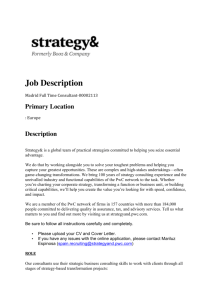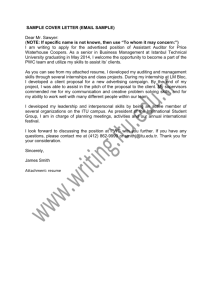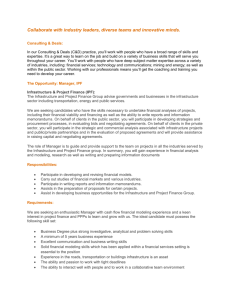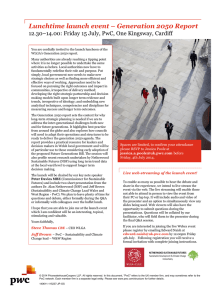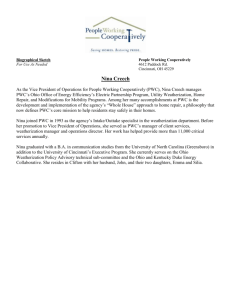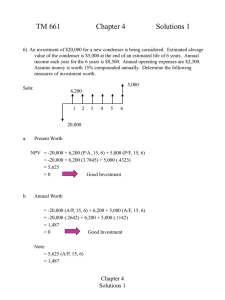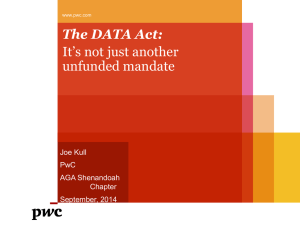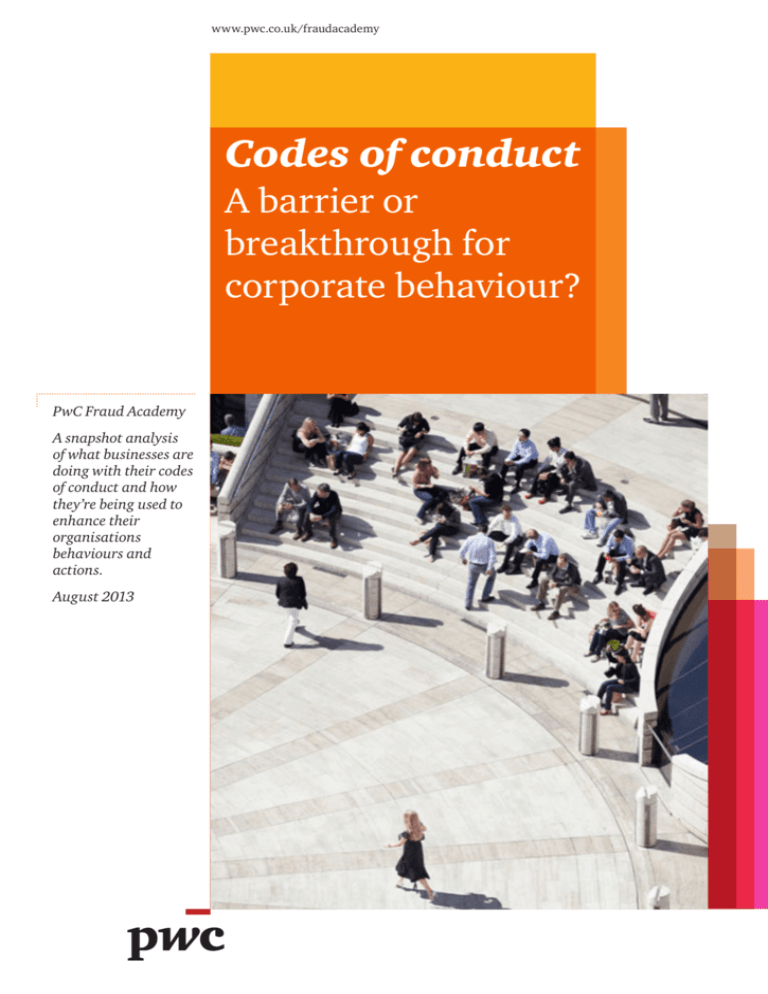
www.pwc.co.uk/fraudacademy
Codes of conduct
A barrier or
breakthrough for
corporate behaviour?
PwC Fraud Academy
A snapshot analysis
of what businesses are
doing with their codes
of conduct and how
they’re being used to
enhance their
organisations
behaviours and
actions.
August 2013
Contents
Spotlight on codes
2
Headline findings
4
Commentary6
Purpose6
Structure8
Relevance10
Content12
What does this mean for business?
15
Contacts16
PwC | Corporate codes of conduct | 3
Spotlight on codes
Does your company have a code of conduct (‘codes’)? If so, how is it being used to enhance organisational
behaviours and actions? After the PwC Fraud Academy raised this topic with clients we decided to create a
snapshot analysis of what businesses are really doing in this area and the challenges they face in making
their codes a reality. The results of our research have given us some interesting findings and highlight the
increased challenge of organisational behaviour and business conduct.
More companies are establishing codes
as a routine part of their governance.
But does this add any real value or is it
simply an exercise that ticks another
box? To some extent this question
highlights mounting concerns about the
mismatch between what companies say
and what they do.
Regular reviews of codes by
organisations that have had business
conduct failings have fuelled this
cynicism. They are cited as evidence
that these top-level corporate
documents are little more than window
dressing. One recent newspaper article
commenting on a new code for a global
financial services institution, released
after the organisation had suffered a
number of significant business failures,
asked the question ‘Is it enough to right
recent wrongs?’.
Codes set out standards of behaviour
and practices for organisations across
the public and private sectors, typically
underpinned by the organisations’
underlying values. Some codes are
labelled Code of Ethics, Code of Business
Practices, Code of Values, or Code of
Behaviours, but the most common term
has become Code of Conduct.
The challenge
Our experience shows that while codes
continue to have relevance and meaning
for many businesses, this is not always
the case. Some organisations still seem
to approach their codes narrowly as a
matter of compliance. They use them as
a set of rules and regulations acting as a
stick to deliver effective governance
through command and control
language. What is clear is that many
2 | Corporate codes of conduct | PwC
organisations are not seizing the
opportunity to use their code as a tool to
inspire an ethical corporate culture.
the emergence of a good practice which
supports learning and decision making
by providing practical tools.
We’ve reviewed a sample of publicly
available codes, and our results support
this concern. Codes are increasingly
converging around the same legallyfocused standards. They continue to rely
on rules-based language and show little
evidence of engagement or dialogue
with their target audience. Despite this
trend towards boilerplate form, there
remains a surprising amount of variety
in quality, with almost a third of the
codes we reviewed omitting key good
practice elements such as board-level
endorsement and explicit reference to
organisational values.
Our approach
However, we also found there is a
growing shift from mainly rules-based
policies to a values-based approach, and
Our insights come from our thinking
and practical experience of advising
various organisations on codes as part of
our focus on integrity and business
conduct. We’ve combined this
experience with the outputs from a
series of debates held by the PwC Fraud
Academy in the UK to contribute to the
points of view contained in this paper.
These debates challenged whether a
code of conduct plays any meaningful
role today in effectively managing
ethical business conduct and corporate
behaviour. Panellists included PwC
experts and corporate ethics and
compliance officers.
A comprehensive definition of ‘codes of conduct’
for the purposes of this paper is:
“Principles, values, standards, or rules of
behaviour that guide the decisions, procedures
and systems of an organisation in a way that (a)
contributes to the welfare of its key stakeholders,
and (b) respects the rights of all constituents
affected by its operations.”
International Federation of Accountants, International
Good Practice Guidance on Defining and Developing an
Effective Code of Conduct, 2007
“A code should be the overarching home for an
organisation’s values and beliefs, inspiring
people to do the right thing every day.
Alignment of both personal and corporate values
is critical to making a successful code a reality.
For a code to work, individuals need to believe in
its purpose which will create authenticity and
consistent delivery.
In this paper we also set the key findings
from our review of 36 UK-based
companies and the 30 publicly available
codes from this group. This provided a
balanced sample of codes from the past
seven years for private sector
organisations of various sizes and
from a variety of industry sectors. Key
areas of focus included purpose,
ownership, structure, language,
relevance and content.
Our view
In our view, dismissing codes merely as
a branch of marketing or good corporate
PR is a mistake. There is a growing
interest in the role that codes can play in
addressing hard-to-reach behaviour
such as decision-making in ‘critical
moments’, and the approach to building
organisations’ risk resilience. In our
review we identified emerging good
practice, including the use of codes to
build staff capability to identify
potential issues and then apply robust
If deployed effectively, a code breathes life into
how and why the organisation exists.”
Tracey Groves,
Partner, PwC
judgement in deciding how they should
they respond. These developments
provide a less cynical perspective on the
ongoing convergence between codes,
and we see this trend as a step towards a
more practical and pragmatic approach
to business ethics.
We believe that codes represent a critical
and integral part of a sustainable
eco-system for the culture of good
business. A good corporate culture is
one that is empathic and demonstrates
care and humanity towards all its
stakeholders. The code should be
presented as a shared statement of
purpose, agreed between the
organisation and its people, and should
embrace the values, character,
behaviour and actions of its leaders,
employees and the organisation. Only
then can the code be used to recalibrate
organisational culture and act as a
‘carrot’ to motivate and encourage the
right behaviours, rather than a ‘stick’ to
impose command and control.
A first step in assessing the effectiveness
and impact of a code on the business is
for organisations to challenge
themselves about where they stand
against some simple assertions, as
outlined here.
Which of the statements below would ring true for your organisation
and for your people?
• We use the code to engage
with our people and
empower them in their
day-to-day working.
• We regularly refresh and
update our code to reflect
new business and ways of
working.
• The code is used to provide
a signpost and common
reference point for our
people to navigate their
way through business
decisions.
• The code is shared by our
leaders and our people and
represents a common sense
of purpose of our business.
• Without our code we would
struggle to articulate who
we are and what we stand
for.
PwC | Corporate codes of conduct | 3
Headline findings
Purpose
1
2
Structure
Relevance
Content
3
4
5
6
4 | Corporate codes of conduct | PwC
There are an increasing number of defensive reasons
to have a code. However, the most meaningful motive
is to communicate your shared purpose.
There is a growing move from mainly rules-based
policies to a values-based approach. Emerging good
practice is to provide practical tools to support
learning and decision making.
Code structure and content is evolving. New
approaches mix an issues structure with references
to the broader social context.
More recent codes include new issues such as a
proactive approach to human rights and use of
social media. It is challenging to keep up with the
growing pace of economic and cultural change.
Codes typically rely on the language of command
and control with little evidence of two way dialogue.
Some industries seem slower than others to adopt
emerging good practice.
85% of companies we reviewed
across the FTSE 350 and a range
of sectors do have a public code
The median average length
of codes reviewed was 33
pages but the sample ranged
from two to 112 pages
“An effective culture is one that
supports a business model and
business practices that have at
their core the fair treatment of
customers and behaviours that
do not harm market integrity.
This is very different from what
we have today where...the focus
has been on ensuring
compliance with a set of rules
rather than doing the right
thing for customers” 1
Clive Adamson
Director of Supervision,
Financial Conduct Agency
1. http://www.fca.org.uk/news/regulation-professionalism
PwC | Corporate codes of conduct | 5
Commentary
Purpose
1
Key finding
There are an increasing number of defensive
reasons to establish or review a code, but a
meaningful motive is one that proactively
and regularly communicates the
organisation’s distinctive culture and
shared sense of purpose.
2
Key finding
A growing number of organisations are looking to
the code to recalibrate their rules-based policies
and processes with a more values-based approach
in order to drive ethical decision-making.
Emerging good practice is to include a mix of
learning and decision-making tools to support
good judgement in alignment with values.
Over the past 20 years codes have
evolved from emerging good practice to
an established norm. In the past,
organisations would make a distinction
between internal codes of conduct,
aimed at setting out standards of
organisational behaviour for
management and staff, and public
statements of ethics, aimed at setting
out the organisation’s values and
commitments to a range of public
stakeholders.
Our PwC Fraud Academy debate
panellists confirmed this rise in
adoption. They noted that formal
codification of business ethics has been
encouraged by a number of both positive
and defensive factors, such as:
Our review of 36 companies across the
FTSE 350 and a range of sectors found
that 85% (thirty) do have a public code.
This finding echoes earlier studies on
the steady growth in code adoption by
larger UK companies.
• Developments in UK corporate
governance – including government
guidance on the UK Bribery Act.
Perhaps unsurprisingly, our review found
that those companies that have
experienced significant or severe external
scrutiny or regulatory sanction during the
past five years have all since updated
their code. However, the majority of
companies that have not undergone this
scrutiny have also updated their codes.
We should also note that the Institute of
Business Ethics (IBE) estimated in 2010
that over 80% of FTSE 100 companies
have an explicit code of conduct or
equivalent, increasing from an estimated
33% in 1993.
6 | Corporate codes of conduct | PwC
• Increasing business complexity
• A desire to engage with a dispersed
and multicultural workforce
• Greater public expectations of
transparency
Codes that have been formulated from
narrowly defensive motivations have
questionable lasting value. Such reactive
codes neither ring true upon closer
inspection nor contribute to sustainable
growth – a finding that was echoed in
our panel discussions. On the other
hand, Enron is an example of a
technically comprehensive code that
was undermined by senior management
choosing to exempt themselves from its
standards, with notorious results. A
code’s authenticity and effectiveness can
only be assessed by the degree to which
it communicates the organisation’s
purpose and culture.
Companies often review their codes
after a crisis. This is sometimes part of a
knee-jerk reaction that gives rise to the
sentiment that ‘the culture needs to
change’. The problem however tends not
to lie with the code’s language, rather it
resides in the success of the business to
embed the code in its day to day
activities.
A number of organisations that have
experienced significant scrutiny have
started to overhaul their basic approach
to compliance, looking beyond processes
and controls to more fundamental issues
of employee motivation and alignment.
Regulators now talk openly about
changing the ‘culture’ of organisations
– reinforcing the view that companies
are really needing to place much more
emphasis on cultures and behaviour
alongside policies, procedures and
controls. This follows earlier lessons
from the field of health and safety which
demonstrated that improvements from
physical safeguards and process
interventions quickly reach a plateau.
Achieving further reductions in
preventable accidents requires a
different focus on culture and
workforce behaviour2.
Our review of sample codes confirmed
this trend. Many previous studies found
that codes typically focused on legal
prohibitions and minimum standards of
behaviour, such as not mistreating
customers. In contrast, a large majority
of our sample went further than this by
outlining positive behaviour, such as
taking personal responsibility for
good customer service. This issue is
discussed in more detail in the section
on code content.
As codes have become an established
part of corporate communications and
governance, their communication role
has shifted from a summary of the
expected standards of behaviour to a
tool that helps people understand and
apply these rules in practice. How
companies choose to communicate their
codes in light of ever evolving social
media channels, and the need to
demonstrate transparency, could be
either a real challenge or a real
opportunity as we progress deeper into
the digital age. The typical focus of
codes has also broadened,
supplementing the ‘what’ of expected
behaviour and the ‘how’ of guidance
principles with an increasing
concentration on the ‘why’ explaining
the organisation’s purpose and culture.
Far from being a flight into aspirational
generalities, we see this new focus on
consistent values as a valid attempt to
grapple with the slippery human
element in the control environment. In
this way, the code can help address real
and difficult compliance issues such as
effective challenge, reporting of bad
news and balancing individual and
collective responsibility.
“Written sensitively, communicated engagingly,
lived and breathed by senior management,
Codes of Ethics can have a positive impact on
the way business is done. They should be
considered as guidance – a tool to use when
you’re not quite sure of the direction to take.
IBE Research shows that training staff in what
the code means to their working life can not
only bring significant financial benefits, but
build an ethical business culture a company can
be proud of.”
Philippa Foster Back
Director, Institute of Business Ethics
2. UK Health and Safety Executive, Behavioural Change and Worker Engagement
Practices within the Construction Sector, 2008
PwC | Corporate codes of conduct | 7
Structure
3
Key finding
The structure and content of codes continues to evolve.
There is a move away from structures based purely around
issues to structures that also identify and map these to
corporate values and purpose.
From our research, the median average
length of codes was 33 pages but
examples ranged from two to 112 pages.
A clear majority of these also made
explicit reference to other sources of
internal policies or public information,
such as more detailed staff guidance and
a corporate sustainability report.
As described in Figure 1 below, not all of
these codes adopt the same structure to
presenting the company’s standards.
Figure
1 – Code structure
Figure 1 - code structure
% of sample codes
7
33
60
Structured by stakeholder groups (e.g. staff customers, government, society)
Structured by issues (e.g. anti-bribery, environment)
Structured by a mix of issues under broad stakeholder themes
8 | Corporate codes of conduct | PwC
A majority of the sample of codes
reviewed were structured on an issue
basis. This continues an observed trend
away from earlier stakeholder
approaches that were based on company
relationships with different groups. The
evolution in code structure has been
accompanied by an increasing
convergence of content around legallyfocused standards such as anti-bribery,
fair competition, environmental
responsibility and health and safety.
These trends may partly reflect a
process of consolidation of the
previously distinct internal codes and
external ethics statements, (as discussed
earlier in the section on code purpose).
This issue-by-issue approach may also
be under revision, however. A sizable
minority of codes we analysed mixed
the two approaches to some degree,
grouping issues and legally-focused
standards according to broad
stakeholder categories such as
employees, customers, government and
broader society. In many cases, this
approach married the practical benefits
of clear standards of behaviour on issues
with the motivational benefits of a social
context and purpose.
PwC’s Code of Conduct, for example,
recognising the complexity of the
markets in which we operate, plays an
important role in relating us back to our
core values.
“We conduct our business within the framework of applicable
professional standards, laws, and regulations together with PwC
policies and standards. However, we also acknowledge that these
standards, laws, regulations and policies do not govern all types of
behaviour. As a result, we also have a Code of Conduct for all PwC
people and firms. This code is based on our vales and it takes them
to the next level – demonstrating our values in action and
contributing to the PwC Experience.”
PwC Code of Conduct
PwC | Corporate codes of conduct | 9
Relevance
4
Key finding
Some recent codes include a number of emerging issues such as;
a proactive approach to human rights, data privacy, due
diligence, and the use of social media. However, there is a
continual challenge as to how a code can keep up with the speed
of change in a global and complex world where market forces
such as competition, cultural diversity and innovation can
challenge and define corporate culture and behaviours.
New themes
Some of the more recently revised codes
set out a new approach to human rights,
based on the 2011 UN Guiding
Principles for Business to adopt
proactive human rights due diligence.
Other additions to the list of typical code
issues include data privacy, use of the
internet at work and social media. The
2013 PwC CEO survey underlines the
importance of these issues in terms of
increasing scrutiny in a global
marketplace with instant and ubiquitous
connectivity.
issue of how to embed the code in a
company’s day-to-day operations. As our
panel discussions identified, there is a
clear need to bring the code to life.
Our debate on how best to embed the
code raised questions about the proper
place of the code in company
incentivisation, with arguments on both
sides of the question of whether to make
compliance with the code a part of
reward and promotion policies. Similar
arguments arose over adding
compliance performance objectives,
such as part of a more balanced
scorecard for all staff.
One of the critical issues facing
organisations seeking to develop
effective codes is to look beyond good
practice design to the more challenging
Of the sample codes that made explicit reference to
the company’s values, 53% mentioned strongly
collectivist values such as teamwork, collaboration
and trust, while only 16% of codes mentioned
strongly individualist values such as freedom,
courage and respect for individuals.
3. 16th Annual Global CEO Survey, http://www.pwc.co.uk/ceo-survey/index.jhtml
10 | Corporate codes of conduct | PwC
Pace and complexity
Today’s global business environment,
where competition, cultural diversity
and innovation can encourage divergent
behaviours to drive growth, raises the
issue of whether it is realistic for a code
to keep up with the pace and speed
of change.
The increasing convergence on legallybased standards might be seen as a
narrowly Western approach to ethics. In
response, codes for multinational
companies may need to reflect and
accommodate other cultural models in
growth markets such as Asia. Given the
strong global focus of many of our
sample codes, this should be a valid
challenge for many of those businesses
to consider.
The picture becomes more complicated
when we look deeper into whether code
structure is biased towards a view of
ethics that is based on narrow individual
self-interest and economic value
generation. In reality, the codes that
made explicit reference to company
values typically referred to traditional
ethical concepts such as trust, integrity
and teamwork, with no strong references
to personal conscience, individual legal
liability or financial value.
In addition, nearly all codes have
adopted speak-up procedures with
explicit permission to bypass line
management hierarchy where
appropriate. Many codes have also
adopted decision-making guides that
inject individualism through their mix of
social, team and individual perspectives.
PwC | Corporate codes of conduct | 11
Content
5
Key finding
Despite the crucial importance of stakeholder
engagement and empowerment, codes
typically still rely on the language of
command and control and vary enormously
in length. There is little evidence of two way
dialogue, apart from the procedural aspects
of whistle blowing.
6
Key finding
Some industries can be seen to be slower than
others to adopt good practice elements of code
design. Organisations in these sectors should
look further afield when benchmarking their
codes for good practice.
A credible code helps build a sustainable
and consistent business culture by
providing a common reference point for
non-negotiable standards, as well as for
making judgements on how to resolve
conflicts between different objectives.
However, as our panel discussions
confirmed, many codes fall short of
providing what staff need to digest the
list of requirements and understand how
company management actually wants
them to behave. This observation was
supported by our review, which identified
a close connection between three key
elements of good practice design.
“A good code sets the tone overall and helps
coordinate everything else, linking corporate
policies to desired behaviours and compliance
certifications. It can thereby contribute to
improved internal communication, more
productive employees and the overall growth
of the business.’’
PwC Fraud Academy,
Code of Conduct debate panellist
12 | Corporate codes of conduct | PwC
Codes making no explicit reference to
company values were typically harder to
find on the company website and were
far more likely to omit other elements of
good practice design, as noted in Figure
2. In addition, while only two sample
codes lacked an explicit commitment to
protecting internal whistleblowers from
retaliation, in both cases these codes
also lacked an explicit reference to
company values.
Our analysis also identified a marked
evolution in the way code content
helped staff recognise issues where they
arose in the workplace rush.
Emerging good practice in this area
includes simple judgement aids that help
staff reframe complex business
dilemmas by using simple moral
principles. These tools range from
ethical prompts and decision framing,
such as through the ‘front page of the
newspaper test’, to encouraging
systematic consideration of basic moral
values, such as care and honesty.
Figure 2 – Company values
Reference to values for all codes
30%
70%
No explicit reference to values
Explicit reference to values
Language and
communication
command and control, with ‘law’ or
‘legal’ being the most common typical
word for almost half of our sample.
Good presentation, while important, is
not sufficient to ensure consistency in
day-to-day behaviour. While overly
formal and legalistic phrasing is best
avoided, spending too much time
focusing on elegant drafting may miss
the importance of developing a clear
understanding of the core messages and
desired behaviour that the code needs to
convey, ideally in simple words.
‘Speak Up’ or whistleblowing procedures
were also present in nearly every code,
underlining the priority of the code as
top-level corporate policy and also the
increased focus on the use of ‘Speak Up’ as
a way of identifying risks. Every such
reference emphasised the protection of
confidential reporting, regardless of
whether an external helpline facility was
offered. Typically, these references were
limited to an opening or concluding
section, with no further discussion of
staff communication or feedback
mechanisms. Combined with the tone of
most codes arising from their reliance on
rules-based language, the relegation of
internal reporting is likely to leave a
stronger (adverse) impression on staff
than the supportive policy commitment
of protection for confidential reporting.
On this point the findings of our review
highlight wide variation in the use of
common words used about conduct and
ethics. We analysed each sample code
for how often they used a word (or close
variant) from a series of typical words
that we would expect to see in a code. As
noted in Figure 3, the six most common
words in our sample of codes relied
extensively on the language of
Key elements of good practice design
1
2
3
Explicit reference to company values
Explicit Board-level endorsement of the code
Learning & training tools
• Frequently-asked-questions
• Hypothetical scenarios and worked examples
• Decision making tools.
PwC | Corporate codes of conduct | 13
Figure 3 – Use of language
Despite the typical issue-by-issue
structure to our sample of codes, there
was surprisingly little sector-specific
content. This may reflect crossfertilisation of issues between sectors, or
an increasing reliance on a default list of
legally-focused standards. However,
there were some notable sector trends.
Figure 3 – Use of language
Breakdown of most frequently used words
4%
9%
9%
As noted in Figure 4, sample codes from
companies in the Financial Services and
Entertainment & Media sectors were
typically lagging behind the trend of
adopting good practice design. In
contrast, codes from organisations in
the Energy, Utility and Mining and the
Aerospace and Defence sectors typically
included the full range of good practice
design. This may be as a result of greater
levels of regulation, enforcement action
and high profile cases.
43%
13%
22%
Law or legal
Customer
Standard
Value
Ethic
Principle
There were also some companies that
had no public code – six of our sample of
thirty-six. Of these six, three came from
the financial services sector.
Industry/sector
profiles
The credit crunch and subsequent
financial crisis has almost certainly
eroded public trust in all types of
business. The resulting increase in
scrutiny has challenged companies in all
sectors to explain how their pursuit of
profit is aligned with their overall
business purpose.
They were also in some cases harder to
find on the company website and a
number did not include any of the three
good practice design (i.e. explicit
reference to company values, explicit
board-level endorsement of the code,
and various learning and training tools).
Figure 4
4 –– Sector
Sector trends
trends
Figure
Breakdown of sector codes – companies adapting the three good practice design elements listed on page 10
All
47%
All
100%
None
20%
Some
33%
All Sectors
Some
20%
All
80%
e
A&D
14 | Corporate codes of conduct | PwC
EU&M
Some
33%
None
67%
E&M
Some
25%
None
75%
FS
What does this mean for business?
We’ve seen codes evolve into more
complex and integrated mix of
structures, content and focus.
One clear observation is that no one size
fits all. Codes are personal, they are
dynamic, they are owned by the
business for the business. Codes must be
authentic and serve the people to whom
the corporate values and purpose have
meaning and relevance.
In our view, businesses need to be
courageous in designing a code that
communicates their purpose and value
in society in an empathic way, rather
than ticking the box.
Regardless of the approach they take,
companies will be judged by their
success in positioning their code as a
tool to guide, inspire and encourage the
right behaviours.
1
2
3
5
Test or pilot the draft code with working groups of
employees from various levels, functions and
locations.
Design and implement a plan to communicate the
agreed code and its practical implications to all
employees and to business partners.
6
7
Diagnose the ‘as is’ state towards ethical conduct,
including analysis of unpredictable behaviours by
business unit, functional activity and code issue. Test
relevance and understanding of the meaning of the
code in those areas that pose a heightened risk of
inconsistency.
Refresh the code to address key gaps in relevance and
meaning, using learning and training tools to address
areas of heightened risk. Make use of positive and
empathic language to re-position ‘doing the right
thing’ as a carrot rather thana stick.
4
As we have said, there is no right answer
to the development of the right code for
each business.
However, we believe that there are some
common practical steps for all
organisations to consider as they
embark on developing and
implementing an effective code:
Develop an agreed board-level understanding of the
purpose of the code as part of a global vision and
strategy for ethical conduct across the business.
Critically review the relevance and meaning of the
current code against this purpose.
Develop approaches to reporting and assessment of
the code’s impact on organisational behaviour,
including the reporting of bad news and decisions on
conflicting objectives.
Consider ways of embedding the code in day-to-day
business, such as through HR linking to performance
management, recruitment and hiring processes.
PwC | Corporate codes of conduct | 15
Contacts
Methodology
Our research for this paper is based around a
series of debates held by our PwC Fraud
Academy in London and Birmingham with
businesses and the analysis of the publicly
held codes of conduct of 30 companies across
the FTSE 350 and a range of sectors.
The PwC Fraud Academy is a community of individuals
based in the UK that have responsibility for managing
fraud, corruption and integrity risk to their organisation.
Members receive:
• Access to regulators, experts and peers through
events, seminars and webcasts.
• Thought leadership, knowledge, benchmarking tools,
surveys and best practice.
• Regular updates and invitations to PwC Fraud
Academy events emailed to you. Our members
include people working in finance, internal audit,
security, in-house legal and compliance functions as
well as specialist fraud teams.
www.pwc.co.uk/fraudacademy
Tracey Groves
Partner,
PwC Forensic Services
T: +44 (0) 20 7804 7131
E: tracey.groves@uk.pwc.com
Joel Osborne
Director,
PwC Forensic Services
T: +44 (0) 20 7213 2009
E: joel.g.osborne@uk.pwc.com
16 | Corporate codes of conduct | PwC
PwC UK helps organisations and individuals create the value they’re looking for. We’re a member of the PwC network of firms in 158 countries with more than 180,000
people committed to delivering quality in assurance, tax and advisory services. Tell us what matters to you and find out more by visiting us at www.pwc.com/uk.
This publication has been prepared for general guidance on matters of interest only, and does not constitute professional advice. You should not act upon the
information contained in this publication without obtaining specific professional advice. No representation or warranty (express or implied) is given as to the accuracy or
completeness of the information contained in this publication, and, to the extent permitted by law, PricewaterhouseCoopers LLP, its members, employees and agents
do not accept or assume any liability, responsibility or duty of care for any consequences of you or anyone else acting, or refraining to act, in reliance on the information
contained in this publication or for any decision based on it.
© 2013 PricewaterhouseCoopers LLP. All rights reserved. In this document, “PwC” refers to the UK member firm, and may sometimes refer to the PwC network. Each
member firm is a separate legal entity. Please see www.pwc.com/structure for further details.
130725-164752-KV-OS

